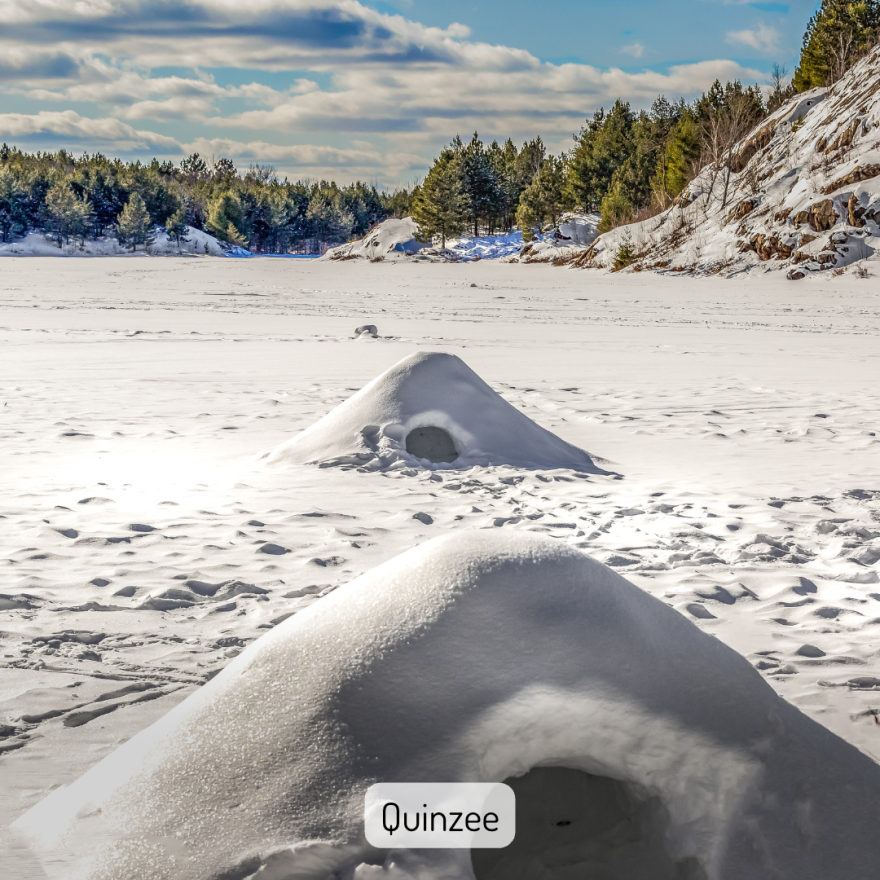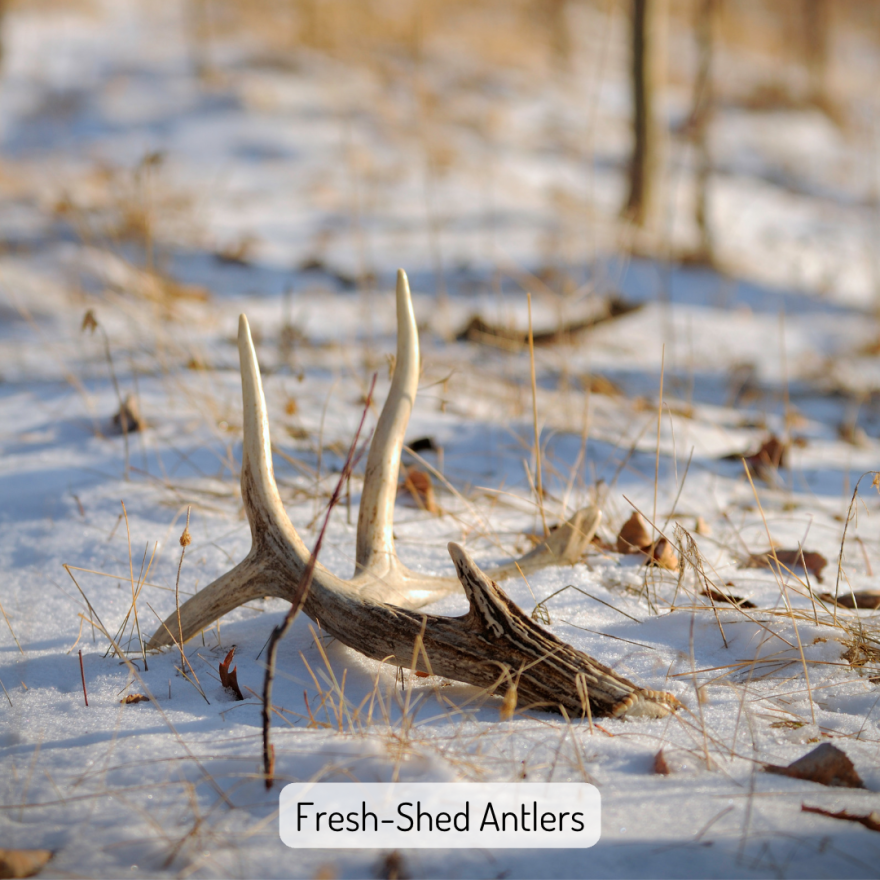Happy Phenology Tuesday! We have four great reports this week: All the way north in Baudette, Chickadees are singing their spring song. Students are building quinzees (snow huts), and John and Scott have a hilarious (to me) discussion about the age of Minnesota Master Naturalists.
Hilary reports from Andrew Pierson’s class at Lake of the Woods School in Bemidji. During the week of January 7th-13th, two Pileated Woodpeckers have been busy pestering a crabapple tree in Mr. Pierson’s yard. Deer are congregating in the Cedars in the school forest, and one student found two fresh-shed antlers. In a sign of eventual spring, the Black-Capped Chickadees have started to sing their spring ‘Phoebe’ songs!
John thanks Hilary for the report, reiterates a few of the observations, and remarks that deer love snacking on cedar trees during the winter. (So do I!) If you have any young cedars in your area, you know you don’t have many deer: otherwise, they’d be eaten! John adds that chickadees singing their “Phoebe” song all the way in Baudette means that spring is on its way.
Isabelle and Nico report from Angie Nistler’s Science Nature Adventure Program at Bemidji Middle School! They’ve been busy building quinzees (snow huts). Collectively, they’ve noticed foggy mornings, exploding cattail seeds, lots of woodpeckers, deer tracks, and male Cardinal! They know it was a male because it was bright red. They’ve also seen turkey tracks and an otter ‘snowbathing’ on the riverbank. Another class put out bird feeders: chickadees are now a common sight (and sound) by the school! The temperatures have been great for forming a quinzee: warm days to melt the top layers of snow, and cold nights to freeze it solid. There hasn’t been any new snow, though. Isabelle and Nico remind us: “Until next time, SNAP to it, get into the wild, and be observant!”
John thanks them for the great report and astute advice! The cattails in John’s area are expanding and close to exploding as well. Before long, he’ll be seeing the seeds blowing everywhere!

Mason reports from Darcie Rolfe and Leigh Jackson’s class at North Shore Community School in Duluth! During the week of January 7th, the class was busy building quinzees (snow huts). These are round snow structures constructed by creating a large mound of snow, allowing it to melt and harden over multiple days, then hollowing it out to create a sheltered space inside. The class created their huge snow pile during the week of January 7th: they’re hoping to fit 3-4 students inside of it next week! Mason notes that January is known to the Ojibwe as the Great Spirit Moon, and it is the month that Earth is closest to the sun- perihelion.
Students noted variable weather last week, which included freezing rain. During their outdoor time, they spotted snow snakes! ‘Snow snakes’ are garlands of snow hanging off of trees that form when near-freezing temperatures, gravity, and ice crystals align in just the right way. The school forest was quiet, without any mammals or birds stirring. There was evidence of their presence, however: students found and identified deer, snowshoe hare, and mice tracks. At the bird feeding station, chickadees and nuthatches were busy filling their tiny avian bellies. Back in their homes, the students were still discovering things in the outdoors: one student spotted a mink exploring their backyard, where it had never been seen before! Another saw a Red-Headed Woodpecker! Their teacher, Ms. Jackson, found several spots in the deep snow where deer had bedded down. “This concludes the phenology report,” Mason says, “Have a great week and be observant!”
John thanks Mason for the great report, reiterates a few of the observations, and adds this great tip: if an animal eats meat (like the American Mink in this report), it’s most likely not a hibernator! Hibernators need to feed every day, and aren’t able to store enough fat to make it through the winter. [Sidenote: Minks are obligate carnivores, meaning they cannot properly digest vegetation. There are some vital nutrients that they can only obtain by eating the meat and organs of other animals. Other obligate carnivores include cats, other weasels, whales, snakes, lizards, dragonflies, and pinnipeds (an evolutionary group including seals, walruses and sea lions.] American Mink are busy this time of year, though rarely seen: they hunt aquatically and are great swimmers, in addition to hunting through subnivean tunnels (tunnels under the snow). What a great experience to see one!
John also notes the sighting of a Red-Headed Woodpecker. They are a less common and generally migratory species (though, as John points out, there have been sightings of them in Minnesota during the winter), so John suspects that the sighting may have been of a Red-Bellied Woodpecker. Red-bellied Woodpeckers are confusingly named, as they don’t have a ton of red on their bellies but do have a prominent red patch on their heads! So, Red-bellied Woodpeckers are often (and understandably!) confused for Red-headed Woodpeckers. John likens it to sightings of Golden Eagles in Minnesota: they definitely happen, but it’s very rare. Most sightings end up being of juvenile Bald Eagles, which strongly resemble Golden Eagles. [My bar for woodpecker accuracy is particularly low: I once heard a kid accidentally refer to a Red-bellied Woodpecker as a ‘Red-peckered Woodhead.” That would definitely make my species list!]

Amy and Patty report from the Master Naturalist Program training at Long Lake Conservation Center. During their stay from January 9th-13th, they stargazed, watched wildlife, and listened to hooting owls! On January 8th, Gichimanidoo-giizis, the Great Spirit Moon in Ojibwe, was just past full. Mars, Jupiter, and the Pleiades were all visible. Someone found an Asiatic Jumping Spider. On the 9th, they saw 12 Pine Grosbeaks, Long Lake’s resident porcupine, and a flying insect! The 10th was also full of adventure, with wolf tracks, ermine, Ruffed Grouse, a second porcupine sighting, AND a chubby vole dragging its belly along the snow. On Wednesday the 11th, they found a ladybug indoors, a snow fly (outdoors), someone dug out a pitcher plant for everyone to admire, and they went to Mille Lacs, where they saw a Bald Eagle and Barred Owl! They even heard two Great Horned Owls calling from behind the dining hall. [They make some great owl impressions here- definitely worth a listen!] Thursday and Friday were full of birds, including Pine Grosbeaks, Red- and White-breasted Nuthatches, Downy, Hairy, and Red-Bellied Woodpeckers, Black-Capped Chickadees, Blue Jays, a small flock of Cedar Waxwings, and a Rough-Legged Hawk. They conclude, “We want to remind everyone to unplug, get outside, and to LIVE CONNECTED!”
John thanks Amy and Patty for the great observations! A hilarious (to me, who knows better) conversation ensues in which John corrects Scott’s confusion about whether Amy and Patty are in high school. As John points out, The Minnesota Master Naturalist Program is open to adult Minnesotans of any age, and is broken into three courses, one for each biome in Minnesota: North Woods and Great Lakes, Big Woods and Big Rivers, and Prairies and Potholes. (Minnesota’s fourth biome, the Tallgrass Aspen Parklands, is nestled within the Big Woods, Big River course.) You only need to complete one course to become a Minnesota Master Naturalist, though you’re welcome to complete all three! [I’ve taken the North Woods/Great Lakes and Big Woods/Big Rivers courses, and enjoyed them! An important aspect of the program is that active members must complete 40 hours of conservation or environmental volunteer service each year, in addition to 8 hours of advanced training. They help connect you to places to volunteer, as well as other resources- I found this job through their newsletter!] John points out that the classes are great for aspiring naturalists, and that his friend and fellow phenologist Larry Weber is one of the instructors!
Finally, I got an email this week from Zach in Cass Lake. He said, “I was fortunate enough to get a road kill whitetail in the ditch visible from my living room. Talk about hours of entertainment. The magpies had exclusive use in the morning, but by 10, 3 adult and one juvenile eagle showed up taking turns. I thought that would be it, but I was wrong. Shortly after a few ravens came by and tried to edge in. Now the all out harassment warfare between the bigger birds is giving the magpies and a few crows plenty of opportunity to exploit the bounty. Who needs ESPN.” His photos are below!


That does it for this week! Remember that you can add your voice to this list: Get in touch with me (smitchell@kaxe.org), John Latimer (jlatimer@kaxe.org), or text "phenology" to 218-326-1234.
For more phenology, subscribe to our Season Watch Newsletter or visit the Season Watch Facebook page.
Funding for this project was provided by the Minnesota Environment and Natural Resources Trust Fund as recommended by the Legislative-Citizen Commission on Minnesota Resources (LCCMR).






